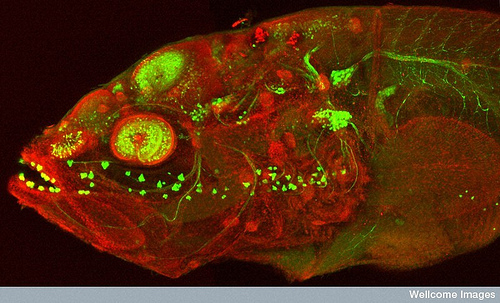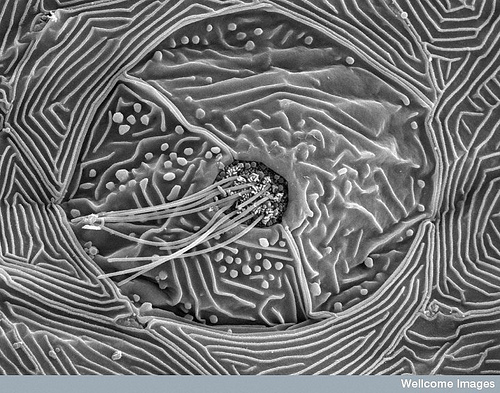
Adaptation
Astyanax mexicanus (Mexican tetra) is a blind cavefish found in Mexico and Central America. It is one of two versions of the species. The other version is a regular sighted fish that lives in surface waters. There are many physical differences between the two fish, along with different patterns of behavior, each being suited best for its environment (Arkive 2013).
The first physical trait that is noticeable is the lack of an
eye. This arose from living in an environment devoid of light.
In places where being able to see does not matter, there is little
purpose to having an eye. The development of the nervous of system and other related organs is
trigged by a protein called sonic hedgehog signal (shh)(Genetics
Home Reference 2013). It is found that in the cavefish, the
hyperactivity of the shh negatively destroys the formation of the
eye, but it is also shown to increase the size of the jaws and the
number of taste buds (Yoshiyuki et al. 2009). The other
noticeable physical trait that is displayed is the lack of
pigmentation of the scales. The cavefish displays a dull grey
color. The suface fish maintains a silver color with a black
line the runs down its sides (Arkive 2013), however there
is one feature that is not visible that runs along the sides of the body,
called the lateral line.
This fish
has a bit more color that may appeal to you!
The development of the nervous of system and other related organs is
trigged by a protein called sonic hedgehog signal (shh)(Genetics
Home Reference 2013). It is found that in the cavefish, the
hyperactivity of the shh negatively destroys the formation of the
eye, but it is also shown to increase the size of the jaws and the
number of taste buds (Yoshiyuki et al. 2009). The other
noticeable physical trait that is displayed is the lack of
pigmentation of the scales. The cavefish displays a dull grey
color. The suface fish maintains a silver color with a black
line the runs down its sides (Arkive 2013), however there
is one feature that is not visible that runs along the sides of the body,
called the lateral line.
This fish
has a bit more color that may appeal to you!
All fish rely on the laterl line system that down the sides of
the body. These lines are responsible for picking up
small vibrations in the surrounding water and pressure changes
giving the fish an accurate representation of the surrounging area
(Britannica 2013).
 The function is not limited to determining out orientation but it is
also used to find prey. Cavefish have been found to use whatis
called VAB, vibration attraction behavior. Cavefish are more
likely than their sighted counterparts to approach a vibration
caused by a prey fish (Yoshizawa et al. 2010). This behavior
was predominantly seen in the cavefish although, a few surface fish
were found to exhibit VAB to a varying degree. This is
evidence that the cavefish came from the surface, and the fish whom
expressed this behavior had a higher survivability and passed it
down to the modern cavefish. This explains how the cavefish
finds food but another behavior can be observed in aiding in
navigating in the dark.
The function is not limited to determining out orientation but it is
also used to find prey. Cavefish have been found to use whatis
called VAB, vibration attraction behavior. Cavefish are more
likely than their sighted counterparts to approach a vibration
caused by a prey fish (Yoshizawa et al. 2010). This behavior
was predominantly seen in the cavefish although, a few surface fish
were found to exhibit VAB to a varying degree. This is
evidence that the cavefish came from the surface, and the fish whom
expressed this behavior had a higher survivability and passed it
down to the modern cavefish. This explains how the cavefish
finds food but another behavior can be observed in aiding in
navigating in the dark.
Cavefish have been found to follow a wall following type of behavior. Much in the same way a blind person touches a wall to find their way around a room. The cavefish will follow closely to a wall to navigate its surroundings. By using their lateral line, the cavefish can sense the pressure difference when it is too close or too far from the wall (Sharma et al. 2009). When compared to the sighted surface fish, the cavefish should a higher preference to a closer proximity to a wall. This gives an advantage to the cavefish, allowing for a faster rate of exploration of their environment and possibly a method of recording their surroundings and building an internal "map" of the surrounding area (Sharma et al. 2009).
One behavior that is seen in the surface fish is the act of shoaling or grouping together. This is a survival technique used by many fish. It is a strategy of numbers to increase the survivability rate against predation from larger fish or from other predators. In the cave setting, there are so few larger predators that this survival technique is null, as it is largely based on sight (Gregson and Burt De Perera 2007). In an open area, fish will shoal together during the day and break off as night falls. In cavefish population there is little use to employ this strategy for a couple reasons. The first, the lack of predators and secondly the competition for food with each other in an environment that food is already difficult to find in (Gregson and Burt de Perera 2007). When surface fish were placed into a dark environment, the act of shoaling diminished. This showed that it is a behavior that is based largley on sight. Link over to interactions to check out some of the ways the cavefish interacts with other organisms. This is the Viperfish, that has made different adaptations to living in an environment with little light.